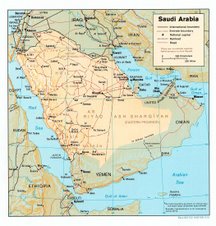Starting from sunset tonight, we spent the evening at a Red Sea resort immersed in folk culture. We watched the sun set over the Red Sea and went back to the resort buildings for tea. After tea, we headed back to the beach. On our way, we were pleasantly surprised by two rows of men in traditional dress welcoming us with music and song. Known as "Raqsa Hejazya" in Arabic, the music and dance represent the culture of the Western Region of the country--primarily Jeddah, Meccah, and Medina. The instruments played included the "Oud" (guitar type), "Dufuf" (drums), "Tablah" (drum), and "Mghani" (harp like). Jamal, a p.e. teacher from the region lead us in the dances. It was great to experience some tradition and feel even more connected with this fascinating, dynamic, multi-faceted culture.


 My pal Nicole from Utah getting her leg hennaed.
My pal Nicole from Utah getting her leg hennaed.
 Nick, David, and Jim getting into the dancing!
Nick, David, and Jim getting into the dancing!
 One of our dance leaders.
One of our dance leaders.
 How cute is she with her apple drink!
How cute is she with her apple drink!
 Two of our hosts (on the right) enjoying "ShiSha," a traditional fruit tobacco pipe.
Two of our hosts (on the right) enjoying "ShiSha," a traditional fruit tobacco pipe.


Henna, a special material (made of a plant extract?), is commonly used for decorating women's hands in Saudi. It is not uncommon for men to have henna tattoos as well! Naturally, I had to have one. Plus, I looked a lot more authentic doing the dances when I had the tattoo also. :-)
It was really enjoyable for all who were there! A few last pictures of the evening...
 My pal Nicole from Utah getting her leg hennaed.
My pal Nicole from Utah getting her leg hennaed. Nick, David, and Jim getting into the dancing!
Nick, David, and Jim getting into the dancing! One of our dance leaders.
One of our dance leaders. How cute is she with her apple drink!
How cute is she with her apple drink! Two of our hosts (on the right) enjoying "ShiSha," a traditional fruit tobacco pipe.
Two of our hosts (on the right) enjoying "ShiSha," a traditional fruit tobacco pipe.












4 comments:
Sol-
How awesome to be immersed in their culture like that!! I'm guessing it may have been one of those experiences that you can't explain in words...hopefully you'll have many of those while you're there. A couple more questions I have:
1. What is the average income in SA?
2. In the US, it seems like a majority of our income goes to material wealth...do you see the same there?
3. Are there other religions besides Muslim openly represented in the country?
4. At any given time, how many Americans are living in SA?
Continue the quest for knowledge.
YEG
p.s. Dr. Cox or Dr. Kelso?
Solomon .. the picture of you wearing the traditional folk attire is so cute :) I had to look at it twice to believe that it was you in those cloth Dancing. I am happy that you got to experience that first hand, it is surly very wonderful to get the feeling of things in such a way. :) But I was wondering did you ask them to wear it? Or did they offer that on their own? :)
Hi Sol,
I've been enjoying your blog site. I tried to comment, but I don't think that it got sent properly! WOW........what an awesome experience! I gave your address to my father in law as I knew that he'd enjoy reading your entries as he grew up in SA w/ his dad working for Aramco. A request I have, if possible, could you bring tiny samples of frankincense and mryh (spelling)back to the USA for me. I was surprised to hear that they are very common as we just hear of them as the gift from the wisemen to the Christ child. It would be fun to see these spices (?). Your photos are beautiful. I especially love to see the children.
Take Care,
Jeannie Kilgore
About henna: it's a paste made from the powdered leaves of the henna (lawsonia inermis) plant, applied to the skin where the dye will penetrate the inner layers and last for days or a couple weeks (until the skin sloughs off--yes, this can be expedited with exfoliation). The paste is usually made from henna powder, water or lemon juice (or sometimes strong tea)--as acidic liquids help the dye in the plant material release--and sometimes spices like cloves or black walnut powder or monoterpene-containing essential oils like lavender, tea tree, cardamom, clove, etc. (to help the color go darker, and also makes it smell pretty as a side effect).
I've heard some "traditional" mixes in India/Pakistan and the Middle East may include less-appetizing stuff like ammonia to get the color as near to black as possible, but obviously that's not very good for the skin!
Post a Comment